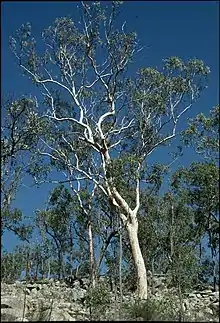| Shiny-barked gum | |
|---|---|
 | |
| Scientific classification | |
| Kingdom: | Plantae |
| Clade: | Tracheophytes |
| Clade: | Angiosperms |
| Clade: | Eudicots |
| Clade: | Rosids |
| Order: | Myrtales |
| Family: | Myrtaceae |
| Genus: | Eucalyptus |
| Species: | E. pachycalyx |
| Binomial name | |
| Eucalyptus pachycalyx | |
Eucalyptus pachycalyx, commonly known as the shiny-barked gum,[3] is a species of tree that is endemic to north-eastern Australia. It has smooth, pale grey, mottled bark, lance-shaped or curved adult leaves, white flowers and cup-shaped or hemispherical fruit.
Description
Eucalyptus pachycalyx is a tree that typically grows to a height of 10–14 m (33–46 ft), often multistemmed or with a crooked trunk, and forms a lignotuber. It has smooth, shining, greyish bark with patches of yellow or orange new bark. Young plants have broadly lance-shaped to egg-shaped leaves that are 80–150 mm (3.1–5.9 in) long and 40–55 mm (1.6–2.2 in) wide. Adult leaves are the same shade of dull green on both sides, lance-shaped to curved, 60–170 mm (2.4–6.7 in) long and 12–25 mm (0.47–0.98 in) wide, tapering to a petiole 10–20 mm (0.39–0.79 in) long. The flower buds are arranged in groups of seven, nine or eleven on peduncles, usually paired in leaf axils. The peduncles are 8–20 mm (0.31–0.79 in) long, the individual buds on pedicels 3–5 mm (0.12–0.20 in) long. Mature buds are oval, 7–12 mm (0.28–0.47 in) long and 4–6 mm (0.16–0.24 in) wide with a conical operculum. Flowering has been observed in February and the flowers are white. The fruit is a woody, cup-shaped or hemispherical capsule 4–6 mm (0.16–0.24 in) long and 7–9 mm (0.28–0.35 in) wide with the valves strongly protruding above the rim.[3][4][5]
Taxonomy
Eucalyptus pachycalyx was first formally described in 1929 by Joseph Maiden and William Blakely in Maiden's book A Critical Revision of the Genus Eucalyptus.[6][7] The specific epithet (pachyphylla) is from ancient Greek, meaning "thick" and "calyx", referring to the thick-walled fruit.[4]
In 1991, Lawrie Johnson and Ken Hill described two subspecies of E. pachycalyx[8] and in 1997 Hill described a third.[9] The descriptions were published in the journal Telopea and the names have been accepted by the Australian Plant Census:
Distribution and habitat
Shiny-barked gum grows in open forest on hills near granite outcrops. It occurs in isolated populations from the Atherton Tableland in Queensland, to far north-eastern New South Wales.[3][4]
Conservation status
Subspecies banyabba is listed as "endangered" under the Australian Government Environment Protection and Biodiversity Conservation Act 1999[13] and under the New South Wales Government Biodiversity Conservation Act 2016.[14] Subspecies waajensis, which only occurs in Queensland, is classified as "endangered" under the Queensland Government Nature Conservation Act 1992.[15] The International Union for the Conservation of Nature listed E. pachycalyx as a least concern species in 2019 noting it has a stable, albeit severely fragmented, population and dominates the areas in which it is found.<ref name="iucn status 5 June 2019">
References
- ↑ Fensham, R.; Laffineur, B.; Collingwood, T. (5 June 2019). "Shiny-barked Gum Eucalyptus pachycalyx". IUCN Red List of Threatened Species. 2019: e.T133376038A133376040. doi:10.2305/IUCN.UK.2019-3.RLTS.T133376038A133376040.en. Retrieved 23 June 2023.
- ↑ "Eucalyptus pachycalyx". Australian Plant Census. Retrieved 24 November 2019.
- 1 2 3 Chippendale, George M. "Eucalyptus pachycalyx". Australian Biological Resources Study, Department of the Environment and Energy, Canberra. Retrieved 24 November 2019.
- 1 2 3 "Eucalyptus pachycalyx subsp. pachycalyx". Euclid: Centre for Australian National Biodiversity Research. Retrieved 30 May 2020.
- ↑ K.Hill. "New South Wales Flora Online: Eucalyptus pachycalyx". Royal Botanic Gardens & Domain Trust, Sydney, Australia.
- ↑ "Eucalyptus pachycalyx". APNI. Retrieved 24 November 2019.
- ↑ Maiden, Joseph (1929). A Critical Revision of the Genus Eucalyptus (Volume 8). Sydney: New South Wales Government Printer. p. 15. Retrieved 24 November 2019.
- ↑ Johnson, Lawrence A.S.; Hill, Kenneth D. (1991). "Systematic studies in the eucalypts - 4 new taxa in Eucalyptus (Myrtaceae)". Telopea. 4 (2): 324–326.
- ↑ Hill, Kenneth (17 December 1997). "New taxa in Eucalyptus (Myrtaceae) from New South Wales and Queensland". Telopea. 7 (3): 187–198. doi:10.7751/telopea19971011.
- ↑ "Eucalyptus pachycalyx subsp. banyabba". Australian Plant Census. Retrieved 24 November 2019.
- ↑ "Eucalyptus pachycalyx subsp. pachycalyx". Australian Plant Census. Retrieved 24 November 2019.
- ↑ "Eucalyptus pachycalyx subsp. waajensis". Australian Plant Census. Retrieved 24 November 2019.
- ↑ "SPRAT Profile Eucalyptus pachycalyx subsp. banyabba". Australian Government Department of the Environment and Energy. Retrieved 24 November 2019.
- ↑ "Banyabba shiny-barked gum - profile". New South Wales Government Office of Environment and Heritage. Retrieved 24 November 2019.
- ↑ "Eucalyptus pachycalyx subsp. waajensis". Queensland Government Department of Environment and Science. Retrieved 24 November 2019.
